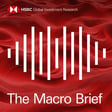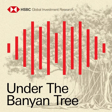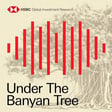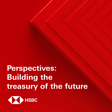Become a Creator today!Start creating today - Share your story with the world!
Start for free
00:00:00
00:00:01

DigiTalks: Digital Assets in Securities Finance
HSBC Markets and Securities Services have been very active in bringing forward initiatives to the market that bring Digital Assets to the Securities Finance space and in this podcast we explore the progress that has been made, the specific use cases where we can see material benefits in using a Digital Asset solution and where we think the industry will go next. Listen as Lindsey Mackie, Product Development Manager, Securities Lending & Treasury at HSBC’s Securities Services discusses Digital Assets in Securities Finance with HSBC’s experts John O’Neill, Global Head of Digital Assets Strategy, and Jamie Anderson, Global Head of Collateral Treasury Trading.
Hosted on Acast. See acast.com/privacy for more information.
Transcript
Introduction to HSBC Global Viewpoint
00:00:00
Speaker
Welcome to HSBC Global Viewpoint, the podcast series that brings together business leaders and industry experts to explore the latest global insights, trends, and opportunities.
00:00:12
Speaker
Make sure you're subscribed to stay up to date with new episodes.
00:00:15
Speaker
Thanks for listening, and now onto today's
Meet the Experts: Lindsay Mackey, John O'Neill, Jamie Anderson
00:00:17
Speaker
show.
00:00:17
Speaker
Hi, my name is Lindsay Mackey, and I'm a Product Development Manager for Securities Lending and Treasury at HSBC Security Services.
Adoption of Digital Assets in Securities Finance
00:00:30
Speaker
I'm joined today by John O'Neill, Global Head of Digital Asset Strategy, and Jamie Anderson, Global Head of Collateral Treasury Trading, to discuss where we're seeing digital assets being utilized in the securities finance space and the initiative HSBC is involved in to use digital assets for specific use cases.
00:00:49
Speaker
John, considering the spectrum and characteristics of digital assets is quite wide,
00:00:54
Speaker
Can you start by clarifying which kind of digital assets are seeing adoption by institutions, specifically in the securities finance space?
Understanding Digital Asset Categories
00:01:02
Speaker
Yeah, thank you, Lindsay.
00:01:04
Speaker
I think actually it's a great question to start with because there's a lot of different ways you can categorize different types of digital assets.
00:01:13
Speaker
I think maybe the most clear way to categorize them are two broad categories.
00:01:19
Speaker
And actually, I think at HSBC, we're in a fairly unique position.
00:01:23
Speaker
because we've created both of these categories on our HSBC Orion platform.
00:01:29
Speaker
So the first category is what we sometimes call natively digital assets.
00:01:34
Speaker
What does that mean?
00:01:35
Speaker
So natively digital means that you create the asset on a blockchain, you only create the asset on a blockchain, and it lives its entire life cycle on that blockchain.
00:01:46
Speaker
And we've done that, as I said, on our HSBC Orion platform, and we've specifically done it for digital bonds.
00:01:54
Speaker
And the reason that we took that approach of creating natively digital bonds on HSBC Orion is
00:02:01
Speaker
is it means that token transfer is aligned with legal title transfer.
00:02:08
Speaker
That is to say, because the bond is not a copy of something which exists elsewhere, it only exists on the blockchain.
00:02:16
Speaker
When you receive the token, you do receive the bond.
00:02:20
Speaker
The two things are the same.
00:02:22
Speaker
The token is the bond.
00:02:24
Speaker
And that alignment between token transfer and legal title transfer is really important to unlock the true benefits of DLT and blockchain, particularly rapid settlement of assets.
The Role of Digital Money and CBDCs
00:02:36
Speaker
That's category one, natively digital.
00:02:39
Speaker
But the second category is also really valid and important for particular use cases.
00:02:45
Speaker
And as I said, we've also done the second category on HSBC Orion, and that's deliberately tokenized copies of real-world physical assets, which of course exist elsewhere.
00:02:57
Speaker
And that's typically an approach that's favored in commodity and physical markets where people don't want just virtual assets.
00:03:05
Speaker
They want to tie back to a real-world physical asset.
00:03:08
Speaker
There's lots of examples of people insist on physical assets.
00:03:12
Speaker
Oil would be one or other commodities.
00:03:16
Speaker
But the one we've pioneered at HSBC, on HSBC Orion, is tokenized physical gold.
00:03:22
Speaker
So the approach that we use there, we often say is a digital twin.
00:03:26
Speaker
That's to say, when you trade the token, of course you're trading the token, but it represents something which exists in the real world.
00:03:34
Speaker
And in this case, it's a physical bar of gold
00:03:38
Speaker
a named specific numbered bar of gold which exists in a HSBC warehouse.
00:03:43
Speaker
So you trade the tokens, you get the benefits of owning the gold, it's tied back to something which is real world and exists in this case in a HSBC warehouse.
00:03:53
Speaker
And then Lindsay, I'll just also add those are the two types of digital assets.
00:03:58
Speaker
But underpinning all of this is developments in digital money, because digital assets are far more efficient if you use digital money to pay for them.
00:04:06
Speaker
We often like to say financial transactions are delivery versus payment, DBP, as we like to say in the market.
00:04:13
Speaker
So having both legs, the delivery and the payment digitized is really powerful and we think is a great development for the future.
00:04:21
Speaker
And because of HSBC's very big presence in payments in FX and trade finance and other money businesses, we're investing a lot of time in central bank digital currencies, tokenized deposits and other innovative forms of digital money.
00:04:36
Speaker
And that all supports our approach on digital assets.
Addressing Inefficiencies in Traditional Finance
00:04:39
Speaker
Thank you, John.
00:04:40
Speaker
Jamie, what are the current inefficiencies in traditional finance infrastructure which can be overcome by investment in the digital ecosystem?
00:04:48
Speaker
We're invested as a bank in a number of initiatives, some more than others, some are internal, some of the points that obviously John has spoken about, also with external platforms and providers.
00:05:01
Speaker
We're doing that because we believe there will be a continued demand on collateral, cross-asset, cross-jurisdictions, and for us to become a lot more effective in our collateral management, but also in a precise and efficient manner.
00:05:17
Speaker
This means getting the right assets to cover the right exposures at the right time.
00:05:22
Speaker
For example, we've developed in-house a collateral optimization engine, which is called Optic.
00:05:27
Speaker
But we developed that with cloud-based solution with Google AI engineers.
00:05:32
Speaker
And that really gave us the ability to enhance our collateral allocation and to leverage that to cover kind of additional exposures outside of our tri-party collateral over the coming months and years.
00:05:44
Speaker
But when they're looking at a pure digital element, using tokenization or native digital assets in the collateral ecosystem,
00:05:52
Speaker
There's a lot more work and time and resources to spend on enhancing that facility and that ability as well.
The Shift to Intraday and 24/7 Collateral Applications
00:05:59
Speaker
We see a move to meeting collateral applications intraday.
00:06:02
Speaker
So that's not end of day covering exposures, it's pure intraday and actually minute by minute.
00:06:08
Speaker
And we may also want to do that outside of normal supplement hours.
00:06:12
Speaker
So 24-5 or actually even potentially 24-7 type environment, being able to use our inventory
00:06:19
Speaker
at all times throughout the day.
00:06:21
Speaker
There's a third element, which is actually using trapped assets.
00:06:25
Speaker
So assets which are not traditionally within the Scrooge financing ecosystem, or ones that are in the ecosystem, but are actually trapped and not usable today.
00:06:33
Speaker
For example, moving a collateral receipt or a digital collateral receipt should be quicker and cheaper to move than the asset itself in some markets.
00:06:42
Speaker
And the fact that we can do that in a precise manner, minute by minute, in a defined way,
00:06:48
Speaker
should really reduce intraday credit and liquidity risk.
00:06:51
Speaker
So with those three elements, moving to a data-rich, real-time, intraday funding and collateral world is definitely exciting, hence why we're investing in this space, but also not without cause for plenty of questions around providers, consumers, who's providing the intraday, who's consuming the intraday,
00:07:10
Speaker
but also risks around delivery.
Tokenization in Pre-Trade and Post-Trade Activities
00:07:12
Speaker
And what are the specific use cases for digital assets or tokenization?
00:07:16
Speaker
Is it mostly a post-trade initiative or the trading side as well?
00:07:21
Speaker
Well, kind of following on really from the comment I made before, there's a number of platforms out there, ION being one, where we're holding native digital assets.
00:07:31
Speaker
And we want to be able to connect that platform, again, as I said, with the traditional collateral management ecosystems.
00:07:39
Speaker
So it is pre-trade because we want to be able to use the digital bonds or digital assets that are being generated into the traditional ecosystem as seamlessly as possible.
00:07:53
Speaker
So doing a repo on a bond that's issued on our own is super important to us and something we're actively working on.
00:08:00
Speaker
I think there's also a case with other providers.
00:08:03
Speaker
We've recently invested in the recent funding round into HQLX.
00:08:09
Speaker
because we think that platform provides us with a number of opportunities.
00:08:13
Speaker
Some are live, some are being worked on.
00:08:16
Speaker
One of the ones that is live is the agency's lending transaction where we have taken and traded recently with Bank of New York via the HCOX platform a digital collateral receipt.
00:08:31
Speaker
Taking that digital collateral receipt versus collateral,
00:08:35
Speaker
intraday atomically settled as a DVD transaction.
00:08:41
Speaker
For us, what does it mean?
00:08:43
Speaker
It means we've taken an asset at a particular time during the day, not leaving it to the settlement cycles to get it late in the day or not being, again, precise with whether we're receiving the asset, but also reducing intraday risk
00:08:58
Speaker
and liquidity risk.
00:08:59
Speaker
I think also there's another trade transaction which is near term that has been worked on by a number of providers, JP Morgan, Boney, Broadridge and others are looking at intraday repo.
00:09:13
Speaker
We're super excited about engaging on those platforms and all those products because we definitely think as a clearing bank that we will need to trade intraday repo
00:09:24
Speaker
to manage our intraday cash flows and also provide some sort of hedging against our intraday liquidity.
Streamlining Digital Asset Markets
00:09:33
Speaker
So, it is free trade and definitely we're engaging across different platforms to be able to mitigate those risks as mentioned earlier.
00:09:41
Speaker
And John, what do you think of this?
00:09:43
Speaker
I think Jamie's put it very well.
00:09:45
Speaker
I think when considering what digital asset markets need to look like in the future, it's good to consider all the activity that happens currently in markets.
00:09:55
Speaker
It may be the case in digital asset markets that certain processes or procedures can be streamlined, and in some cases, maybe even entirely eliminated.
00:10:03
Speaker
But broad categories of activity like free and post-trade are certainly going to exist.
00:10:08
Speaker
And I think it's very important when we consider market structure change, market development, and also infrastructure that can support all of that.
The 2024 Takeoff for Digital Assets
00:10:18
Speaker
We are considering the full range, the full lifecycle of trading activity, making sure we're deploying platforms like HSBC Orion or like some of the third party platforms that Jamie's mentioned, which can improve process and do things better, which is always the theme, I think, for digital assets.
00:10:36
Speaker
And where is the industry right now and what progress have we seen so far?
00:10:41
Speaker
I'd say, Lindsay, the industry right now is at what I would think of as a takeoff moment.
00:10:47
Speaker
I think the truth is the development of digital asset markets has taken a long time.
00:10:51
Speaker
It's taken longer than most of us who have been involved in this subject would wish.
00:10:56
Speaker
But what we're seeing in 2024 for the first time is a takeoff in terms of liquidity.
00:11:01
Speaker
And for me, in all markets, liquidity is always the theme.
00:11:06
Speaker
Digital asset markets should be as liquid as conventional markets.
00:11:09
Speaker
They should be as easy to use as conventional markets.
00:11:12
Speaker
And I think we'll really know who has succeeded with digital assets when they're treated very much as business as usual activity rather than one-off.
00:11:21
Speaker
or exciting or interesting trades.
00:11:24
Speaker
And we're seeing the first steps towards that.
00:11:26
Speaker
On our Orion platform, when we launched in Hong Kong in February this year, we had really unprecedented demand for the digital bonds that we put live as part of that issuance with the Hong Kong government.
00:11:38
Speaker
We put four digital bonds live.
00:11:40
Speaker
It was a multi-currency issuance, which was exciting and a world first.
00:11:45
Speaker
But what was perhaps even more exciting was the range of demand
00:11:49
Speaker
that we saw for those bonds from investors and others.
00:11:53
Speaker
And we saw more than a billion US dollars worth of demand.
00:11:57
Speaker
We reached the issuance limit for the bonds, which was 6 billion Hong Kong dollars.
00:12:01
Speaker
So that's about 750 million US dollars
00:12:05
Speaker
And we saw a very wide range of investors, more than 50 investors, which was really unprecedented for a digital bond issuance.
00:12:12
Speaker
And I think that example hopefully speaks to the themes I described, which is a liquid market, liquid in the primary, trades in the secondary, repo and securities financing activity on those bonds, which is always critical for market development, and increasingly creating a culture of
00:12:31
Speaker
where the benefits of digital assets are realized, but investors and others treat them pretty much as a normal asset, have a wide range of participation and always a wide range of liquidity.
00:12:43
Speaker
So, Lindsay, I think this year is where the market is finally reaching that point.
Conclusion: Progress and Potential of Digital Assets
00:12:48
Speaker
I think that's a very exciting moment.
00:12:50
Speaker
I have to agree with John.
00:12:52
Speaker
I think in terms of pace of change, we see it on the trading side, on the collateral treasury side, we definitely see an acceleration in the conference
00:13:08
Speaker
Thank you both for sharing your thoughts and the initiatives that are bringing digital assets to the securities finance space.
00:13:15
Speaker
It feels like we're at an exciting stage in the journey of utilizing this technology to provide new solutions to our counterparties.
00:13:22
Speaker
Thank you for joining us at HSBC Global Viewpoint.
00:13:26
Speaker
We hope you enjoyed the discussion.
00:13:28
Speaker
Make sure you're subscribed to stay up to date with new episodes.












